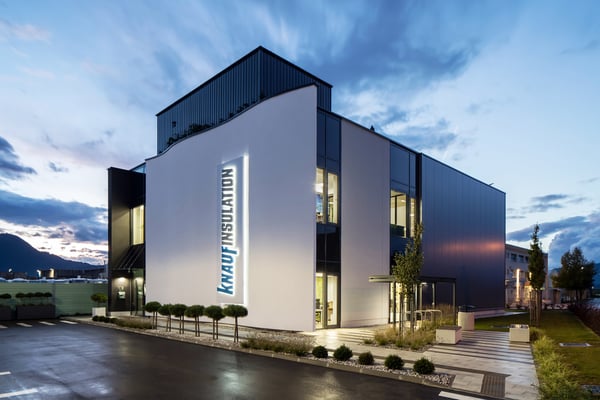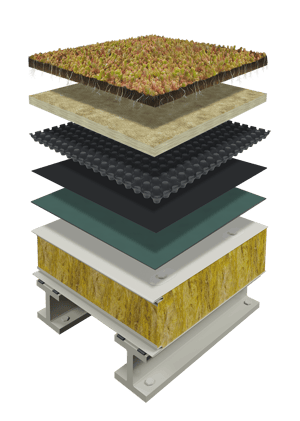More and more businesses are becoming aware of the fact that climate change is a significant threat and are acting to do their part in crisis prevention efforts. Many are producing sustainability strategies and action plans as a part of their identity and goals.
Without making sure the facilities you use are sustainable, can you really call yourself a sustainable business? We are all aware that it is not always an easy task. Sometimes the best green solutions are simply too cost-prohibitive, despite the best of efforts, or turn out not to be compatible with the needs of your business. However, green infrastructure is evolving and addressing such concerns. In this paper, we will take a look at what you can do to make your buildings both green and economically efficient. But first, some overview.Environmental Impact
Green roofs and other green infrastructure can help ease many of the effects of industry on the environment. Research even shows a 10% increase in green cover could reduce the projected increase in urban temperatures from global warming.
If you are a business that uses warehouse facilities or any kind of buildings that cover large areas, it is possible to turn the roofs into air-cleaning surfaces that have great CO2 absorption properties. Green surfaces even act as artificial habitats for insects, such as bees and butterflies, as well as attracting birds and bats.

Knauf Insulation Experience Center, Škofja Loka, Slovenia
Legislation Making Green Roofs Mandatory
France passed legislation that commercial buildings must be partially covered by either green roofs or solar panels in March 2015. In Copenhagen, Denmark, green roofs have been mandatory on all new roofs with a pitch under 30 degrees since 2010, setting the example that many other European countries may follow in the future.
Toronto in Canada adopted a by-law in 2009 mandating green roofs to be installed on both industrial and residential buildings. In Australia, landscape architects advocated to make green roofs compulsory on new commercial buildings for the environmental benefit of cities. In Singapore as well, every contractor/builder is obliged by the law to fully compensate for any green surface lost – this is done with green roofs, green facades, green parking spaces, etc.
Germany has seen the benefits of applying green roofs for many years now. The first modern green roofs in the 1960s were shortly followed by technological improvements and supportive policies by the local governments. German federal nature conservation laws demand compensation for environmental damage in greenfield developments, which is generally done by installing green infrastructure. Today, Germany has between 100 and 150 million square metres of green roofs, as estimated by the German Roof Gardens Association.
Legislation in the developed world is clearly moving in the general direction of encouraging green infrastructure in all commercial buildings, which is an important sign for all future development projects.
Economically Sound and Practical Solutions
Bespoke architectural solutions are not a viable option when constructing commercial facilities that are governed by strict budgets. This is why green solutions for businesses must come in the form of modular systems and easy-to-adapt formats. Naturally, it is also important to ensure that the solutions are easy to maintain to prevent additional costs appearing over the years and jeopardizing the success and financial sustainability of the business venture.
Urbanscape Green Roofs on modular building solutions
The products from our Urbanscape Green Roof line are designed in a way that allows them to be easily installed both in the case of new facilities and existing corporate modular / sandwich panel buildings. The system's light weight – about six times less than traditional green roof systems – makes it ideal when dealing with renovations and projects where mass is a concern.
It is a ready-made system with many benefits that arise from careful planning, experience, expertise and vigorous testing and development from our engineers. This has the potential to reduce drafting time for architects as well, avoiding dilemmas when combining different construction systems. All construction details are readily available in CAD designs, which makes importing and implementing them in building plans easy and clear. Therefore, it can also reduce the cost of planning, as well as installation and maintenance!
URBANSCAPE® Green Roof System is therefore an optimal solution for all flat roof sandwich panel buildings and a great idea for converting roofs into a place of rest and at the same time enriching the visual urban experience from varied perspectives.
CAD DESIGNS FOR GREEN ROOF SYSTEMWe have prepared some detail drawings (CAD designs) to assist architects and other designers with their work while designing a green roof.
|
Ana Belčič, M. Arch. - Studio MIAO
Sources:
(1) Germany’s green roofs offer lesson on climate change adaptation - Zhang Dongfang, China Dialogue, 2017
(2) Toronto makes green roofs the law, approves controversial bike lanes – Lloyd Alter, 2009
https://www.treehugger.com/corporate-responsibility/toronto-makes-green-roofs-the-law-approves-controversial-bike-lanes.html
(3) France mandates green roofs for all new commercial construction – Katie Gloede, 2015
https://www.architectmagazine.com/technology/france-mandates-green-roofs-for-all-new-commercial-construction_o
(4) Urbanscape green roof performance evaluation report
http://info.green-urbanscape.com/download-free-greenroof-performance-evaluation-report



